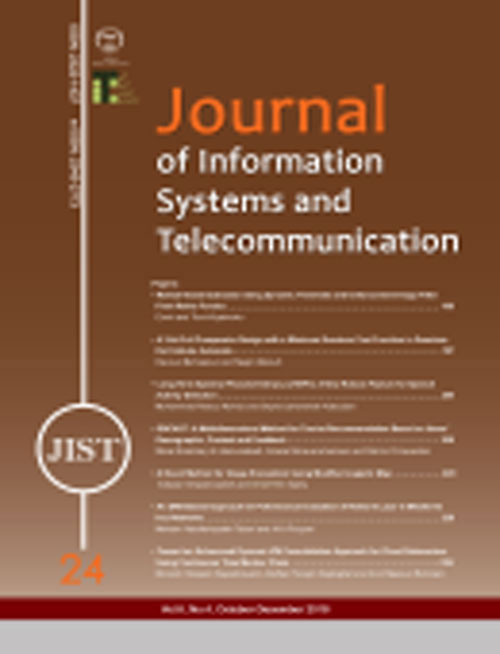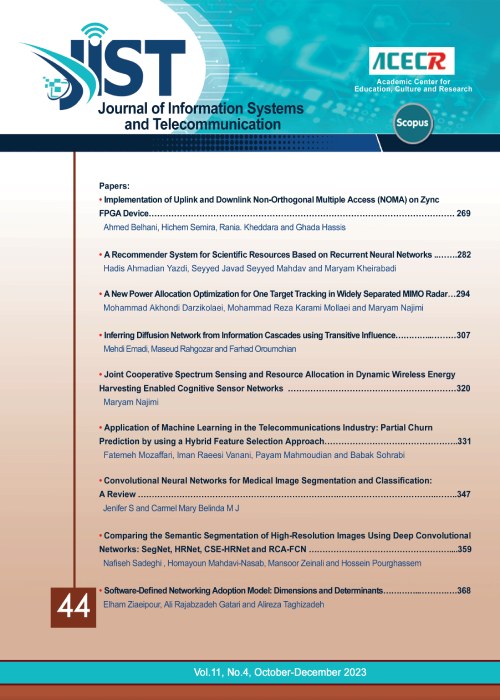فهرست مطالب

Journal of Information Systems and Telecommunication
Volume:7 Issue: 2, Apr-Jun 2019
- تاریخ انتشار: 1398/10/22
- تعداد عناوین: 7
-
-
Pages 87-95
The emerging field of compressive sensing (CS) enables the reconstruction of the signal from a small set of linear projections. Traditional CS deals with a single signal; while one can jointly reconstruct multiple signals via distributed CS (DCS) algorithm. DCS inversion method exploits both the inter- and intra-signal correlations via joint sparsity models (JSM). Since the wavelet coefficients of many signals is sparse, in this paper, the wavelet transform is used as sparsifying transform, and a new wavelet-based Bayesian DCS algorithm (WB-DCS) is proposed, which takes into account the inter-scale dependencies among the wavelet coefficients via hidden Markov tree model (HMT), as well as the inter-signal correlations. This paper uses the Bayesian procedure to statistically model this correlations via the prior distributions. Also, in this work, a type-1 JSM (JSM-1) signal model is used for jointly sparse signals, in which every sparse coefficient vector is considered as the sum of a common component and an innovation component. In order to jointly reconstruct multiple sparse signals, the centralized approach is used in DCS, in which all the data is processed in the fusion center (FC). Also, variational Bayes (VB) procedure is used to infer the posterior distributions of unknown variables. Simulation results demonstrate that the structure exploited within the wavelet coefficients provides superior performance in terms of average reconstruction error and structural similarity index.
Keywords: Distributed Compressive Sensing, Joint Saprsity, Signal Reconstruction -
Pages 96-109
By switching the computational load from mobile devices to the cloud, Mobile Cloud Computing (MCC) allows mobile devices to offer a wider range of functionalities. There are several issues in using mobile devices as resource providers, including unstable wireless connections, limited energy capacity, and frequent location changes. Fault tolerance and reliable resource allocation are among the challenges encountered by mobile service providers in MCC. In this paper, a new reliable resource allocation and fault tolerance mechanism is proposed in order to apply a fully distributed resource allocation algorithm without exploiting any central component. The objective is to improve the reliability of mobile resources. The proposed approach involves two steps: (1) Predicting device status by gathering contextual information and applying TOPSIS to prevent faults caused by volatility of mobile devices, and (2) Adapting replication and checkpointing methods to fault tolerance. A context-aware reliable offloading middleware is developed to collect contextual information and manage the offloading process. To evaluate the proposed method, several experiments are run in a real environment. The results indicate improvements in success rates, completion time, and energy consumption for tasks with high computational loads.
Keywords: Mobile Cloud Computing, Fault tolerance, Reliability, Replication, Checkpointing -
Pages 110-119
Reverberation Chamber (RC) is new type of measurement equipment used in electromagnetic compatibility and antenna tests and capable to produce an almost uniform electric filed inside a Working Volume (WV). In this paper, the Standard Deviation (SD) of a small size RC, as a field uniformity criterion is investigated in an existing RC. A highly detailed three-dimensional model of chamber including its stirrers, antenna, WV, and its door create to verify the field uniformity of a RTS60 reverberation chamber. The removal of reverberation chamber’s stirrers shows that they have a direct effect on the uniformity of field. Besides that, the SD of the chamber is measured by using an electric field probe. A comparison between the simulation and measurement also is done in order to confirm the uniformity of the electric fields.
Keywords: reverberation chamber, stirrer, Electromagnetic Compatibility tests, antenna gain, efficiency, standard deviation -
Pages 120-133
The proper representation of textual documents has been the greatest challenge in text mining applications. In this paper, a knowledge-based representation model for text documents is introduced. The system works by integrating structured knowledge in the core components of the system. Semantic, lexical, syntactical and structural features are identified by the pre-processing module. The enrichment module is introduced to identify contextually similar concepts and concept maps for improving the representation. The information content of documents and the enriched contents are fused (merged) into the graphical structure of semantic network to form a unified and comprehensive representation of documents. The 20Newsgroup and Reuters-21578 dataset are used for evaluation. The evaluation results suggest that the proposed method exhibits a high level of accuracy, recall and precision. The results also indicate that even when a small portion of information content is available, the proposed method performs well in standard text mining applications.
Keywords: Semantic document representation, Ontology, Knowledge base, Semantic network, Information fusion -
Pages 134-143
We propose the problem of joint spectrum sensing and determining the mobile primary user location based on compressive sensing in cognitive sensor networks which saving energy is a crucial issue. By utilizing compressive sensing, the ratio of measurement for the sensing nodes is considerably reduced. So, the energy consumption is improved significantly in spectrum sensing. We also consider the multi-antenna sensors to save more energy. On the other hand, multi-antenna sensor utilization is a proper solution instead of applying more sensors. We formulate the problem of network lifetime maximization and finding the mobile primary user position by sensor selection under the detection performance and accuracy of localization constraints. For this purpose, we propose a cooperative game to study this problem. It is shown that with the proposed game, the network lifetime is maximized while sensors which participate in spectrum sensing and primary user localization are determined. Simulation results show that the network lifetime is improved while the detection performance constraint is satisfied and the location of the primary user is determined with high accuracy
Keywords: Cooperative Spectrum Sensing, Compressive Sensing, Mobile Primary User Localization, Detection Performance, Game Theory -
Pages 144-154
Maintenance process plays a vital role in oil and gas refineries. Process owner expectations and new technology acquisition have been changing the mindset of domain experts to the new maintenance approaches from reactive to condition-based maintenance models, so maintenance is considered as a part of the business process which provides added value for the company. With the advent of Neuro-fuzzy and intelligent systems and potential capability of them, we have presented a new model by using neuro-fuzzy model and MAPE control loop using real-world data to improve the reliability and also decreasing the cost of maintenance for a control valve in a gas refinery. In this research, we employed ANFIS model for the reasoning process which has six inputs (Inlet/outlet Pressures, temperature, flow rate, controller output, and valve rod displacement) and one output that is the type of failure of the control valve. We considered the most failures based on domain expert knowledge. We also made use of the MAPE as a control loop to unceasingly monitor, analyze, plan and finally execute the process of prediction of failures. Due to undertaken improvement, there was a considerable change in reliability and financial indices. Moreover, we compared the proposed approach with two different methods. The result of the comparison shows that our proposed model is comprehensively more acceptable as compared to the other approaches by accuracy.
Keywords: Condition-Based Maintenance, Neuro-fuzzy, Autonomic computing, Control valve -
Pages 154-164
Nowadays, most books and information resources or even movies and application programs are produced and reproduced as information goods. Regarding characteristics of information goods, its cost structure and market, the usual and traditional pricing methods for such commodity are not useful and the information goods pricing has undergone innovative approaches. The purpose of product pricing is to find an optimal spot for maximizing manufacturers' profits and consumers' desirability. Undoubtedly, in order to achieve this goal, it is necessary to adopt appropriate strategies and implement innovative tactics. Innovative strategies and tactics that reflect the analysis of market share, customer behavior change, pattern of cost, customer preferences, quick response to customer needs, market forecast, appropriate response to market changes, customer retention, discovery of their specific requirements, reduce costs and increase customer satisfaction. In this research, 32 papers selected among 540 articles from prestigious articles to create a canvas that contains more than 20 possible avenues for innovations in the field of information goods pricing, which can be use in the companies producing information goods, regardless of size, nationality, and type of information goods produced. There are also a few key ideas on how to increase both profits and customer satisfaction, and the introduction of three open issues for future research in the field of information goods pricing is one of the achievements of this research.
Keywords: Innovation, Pricing, Information goods, Customer satisfaction


